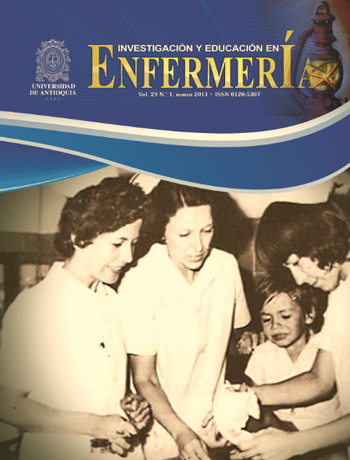Creation of a career certification test for nursing
DOI:
https://doi.org/10.17533/udea.iee.8528Keywords:
Evaluation; professional competence; nursing.Abstract
Objective. To evaluate the utility of a career certification test, as a written test to measure skills defined in the graduate profile of the nursing curriculum.
Methodology. The test was developed based in the definition of its characteristics, approach of the objectives, evaluated content definition, description of the questions characteristics, and determine the approval or disapproval nature of the test. After review and classification of the questions, pilot sampling was performed allowing the construction of the final tool.
Results. From the total of piloted questions, a total of 256 questions were accepted, 31.3% of them were rescued post psychometric analysis, they were used for the first version of the test applied to nurses and matron-nurses, 36 students took it reaching a score of 52.4±4.7. Considering the above, the average grade of this cohort was 4.9±0.5 (in a 1 to 7 scale).
Conclusion. The certification test measured a wide range of professional skills needed for a quality practice. It is important to know that the election of a “written test” modality allows measuring only cognitive knowledge and skills. So it must be assured through curriculum in each course, to achieve technical abilities and the correct attitudes.
Downloads
References
(1) Pontificia Universidad Católica de Chile. Resolución Vicerrectoría Académica Nº 92/2001. Chile: Pontificia Universidad Católica de Chile; 2001.
(2) Pontificia Universidad Católica de Chile. Resolución Vicerrectoría Académica Nº 150/2002. Chile: Pontificia Universidad Católica de Chile; 2002.
(3) Pontificia Universidad Católica de Chile. Resolución Vicerrectoría Académica Nº 62/2005. Chile: Pontificia Universidad Católica de Chile; 2005.
(4) Pontificia Universidad Católica de Chile. Proyecto Educativo [internet]. Chile: Pontificia Universidad Católica de Chile. [acceso 8 de julio de 2008]. Disponible en: http://www.uc.cl/webpuc/site/launiversidad/ proyectoeducativo.html
(5) Pontificia Universidad Católica de Chile. Reglamento Examen de Titulación Currículo 2000, Modalidad Estudio Bibliográfico. Chile: Pontificia Universidad Católica de Chile; 2000.
(6) Ferrer X, Urrutia T, Uribe C. Evaluación examen de titulación modalidad estudio bibliográfico. Chile: Pontificia Universidad Católica de Chile; 2006.
(7) Henríquez O, Mena B. Habilitación profesional. Condiciones para el aseguramiento de la calidad de la educación médica y condiciones para la confianza recíproca. Experiencia y visión de ASOFAMECH. Rev Méd Chile. 2005;133(4):483-94.
(8) Cizek G, Bunch M. Standard setting. A guide to establishing and evaluating performance standards on tests. California: Sage Publications; 2007.
(9) Crocker L, Algina J. Introduction to classical and modern test theory. Fort Worth: Harcourt Brace Jovanovich; 1986.
(10) Wright C. Evaluación de los aprendizajes a través de pruebas escritas. Chile: Pontificia Universidad Católica de Chile; 2007.
(11) Vargas L, Rivera N. El examen de titulación en odontología como indicador de calidad profesional en la Universidad Michoacana de San Nicolás de Hidalgo. Educ Med Super. [Internet]. 2006;20(3). [acceso 8 de julio de 2008]. Disponible en: http://bvs.sld.cu/ revistas/ems/vol20_03_06/ems07306.htm
(12) Colombia. Instituto Colombiano para el Fomento de la Educación. Marco de Fundamentación Conceptual y Especificaciones de Prueba 2004 [internet]. Bogotá: ICFES; 2004 [acceso 25 de agosto de 2010]. Disponible en: http://www.utadeo.edu. co/programas/pregrados/ing_alimentos/terminos_ de_referencia.pdf
(13) Real E, Olea J, Ponsod V, Revuelta J. Abad F. Análisis de la dificultad de un test de matemáticas mediante un modelo componencial. Psicologica. 1999;20:121-34.
(14) Bravo AA, Fernández JV. La evaluación convencional frente a los nuevos modelos de evaluación auténtica. Psicothema. 2000;12:95-9.
(15) Camilloni AR. La calidad de los programas de evaluación y de los instrumentos que los integran [internet]. Buenos Aires: Paidos; 1998 [acceso 25 de agosto 2010]. Disponible en: http://misioneseduca. gov.ar/downloads
Downloads
Published
How to Cite
Issue
Section
License
Derechos de propiedad / Direitos de Propriedade
English: If the article is accepted for publication, all copyright will be of exclusive property of Investigación y Educación en Enfermería. The text and the graphics included in the publication are exclusive responsibility of the authors and not necessarily reflect the thought of the Editorial Committee.
Español: Si el artículo es aprobado para publicación, todos los derechos son de propiedad de Investigación y Educación en Enfermería. El texto y las gráficas incluidas en la publicación son de exclusiva responsabilidad de los autores y no necesariamente refleja el pensamiento del Comité Editorial.
Português: Se o artigo for aceito para publicação, todos os direitos autorais serão de propriedade exclusiva de Investigación y Educación en Enfermería. O texto e os gráficos incluídos na publicação são de responsabilidade exclusiva dos autores e não refletem necessariamente o pensamento do Comitê Editorial.















